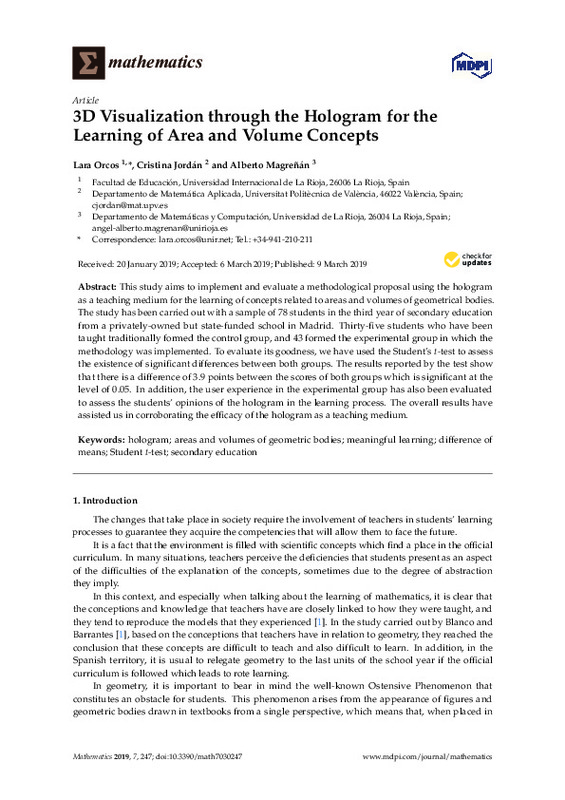Toledo, R. S., Cruz, G. V., Zaldo, A. F., Lunazzi, J. J., & Magalhães, D. S. F. (2009). El holograma y su utilización como un medio de enseñanza de la física en ingeniería. Revista Brasileira de Ensino de Física, 31(1), 1401.1-1401.12. doi:10.1590/s1806-11172009000100007
Orcos, L., & Magreñán, Á. A. (2018). The hologram as a teaching medium for the acquisition of STEM contents. International Journal of Learning Technology, 13(2), 163. doi:10.1504/ijlt.2018.092097
Fabres Fernández, R. (2016). Estrategias metodológicas para la enseñanza y el aprendizaje de la geometría, utilizadas por docentes de segundo ciclo, con la finalidad de generar una propuesta metodológica atingente a los contenidos. Estudios pedagógicos (Valdivia), 42(1), 87-105. doi:10.4067/s0718-07052016000100006
[+]
Toledo, R. S., Cruz, G. V., Zaldo, A. F., Lunazzi, J. J., & Magalhães, D. S. F. (2009). El holograma y su utilización como un medio de enseñanza de la física en ingeniería. Revista Brasileira de Ensino de Física, 31(1), 1401.1-1401.12. doi:10.1590/s1806-11172009000100007
Orcos, L., & Magreñán, Á. A. (2018). The hologram as a teaching medium for the acquisition of STEM contents. International Journal of Learning Technology, 13(2), 163. doi:10.1504/ijlt.2018.092097
Fabres Fernández, R. (2016). Estrategias metodológicas para la enseñanza y el aprendizaje de la geometría, utilizadas por docentes de segundo ciclo, con la finalidad de generar una propuesta metodológica atingente a los contenidos. Estudios pedagógicos (Valdivia), 42(1), 87-105. doi:10.4067/s0718-07052016000100006
Bishop, A. J. (1980). Spatial abilities and mathematics education?A review. Educational Studies in Mathematics, 11(3), 257-269. doi:10.1007/bf00697739
Gabor, D. (1972). Holography, 1948-1971. Science, 177(4046), 299-313. doi:10.1126/science.177.4046.299
Lee, H. (2013). 3D Holographic Technology and Its Educational Potential. TechTrends, 57(4), 34-39. doi:10.1007/s11528-013-0675-8
Moyer-Packenham, P. S., Lommatsch, C. W., Litster, K., Ashby, J., Bullock, E. K., Roxburgh, A. L., … Jordan, K. (2019). How design features in digital math games support learning and mathematics connections. Computers in Human Behavior, 91, 316-332. doi:10.1016/j.chb.2018.09.036
Martín-Gutiérrez, J., Luís Saorín, J., Contero, M., Alcañiz, M., Pérez-López, D. C., & Ortega, M. (2010). Design and validation of an augmented book for spatial abilities development in engineering students. Computers & Graphics, 34(1), 77-91. doi:10.1016/j.cag.2009.11.003
Kesim, M., & Ozarslan, Y. (2012). Augmented Reality in Education: Current Technologies and the Potential for Education. Procedia - Social and Behavioral Sciences, 47, 297-302. doi:10.1016/j.sbspro.2012.06.654
LeTendre, G., McGinnis, E., Mitra, D., Montgomery, R., & Pendola, A. (2018). American Journal of Education: retos y oportunidades en las ciencias translacionales y la zona gris de la publicación académica. Revista Española de Pedagogía, 76(271). doi:10.22550/rep76-3-2018-01
[-]









